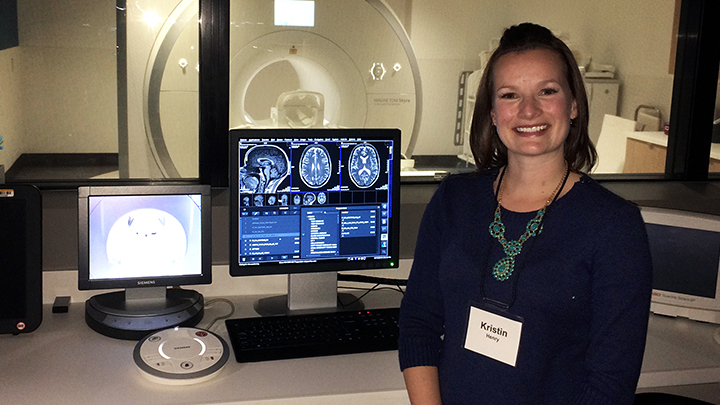
October 14, 2016

Despite having surgery for a brain tumour as a teen, Kristin Henry, now 33, lived with debilitating headaches for more than a decade until the detailed images of a 3T MRI scanner allowed her neurosurgeon to pinpoint and remove the rest of her tumour. Today the young mother is pain-free.
Story by Tadra Boulton & Gregory Kennedy
EDMONTON — At 15, Kristin Henry feared she would have to live with pain for the rest of her life. A plum-sized portion of her brain tumour had just been removed — but the teenager still suffered debilitating headaches because some of it had to be left behind.
Fast-forward to the present, and Henry — now 33 and pain-free — is recently married with a baby and enjoying every precious minute of her new lease on life.
What made Henry’s dramatic turnaround possible was new scanning technology which allowed doctors to safely pinpoint and remove her remaining tumour four years ago, with the arrival of the city’s first intra-operative 3T MRI for use during surgeries.
Now clinical patients can benefit from this technology, thanks to the arrival this month of the city’s first clinical 3T MRI — fully funded by community support — which is expected to serve 10,000 patients a year at Edmonton’s University of Alberta Hospital (UAH).
Its arrival marks a major milestone in the University Hospital Foundation’s Brain Centre Campaign, as the first 3T MRI dedicated to outpatient diagnosis and care.
Magnetic Resonance Imaging (MRI) uses a magnetic field and radio waves to make precise images of the body, which allows physicians to diagnose conditions affecting the spine, vascular and musculoskeletal systems.
The 3Tesla Magnetic Resonance Imaging (3T MRI) scanner — the most advanced incarnation of this non-invasive and radiation-free technology — is a more powerful version of this diagnostic tool that allows higher-resolution images than ever before. This further helps in the care of patients with neurological and mental health conditions, including epilepsy, concussion, stroke, depression and neuro-developmental disorders.
Dr. Bill Anderson, Director of Diagnostic Imaging for the Edmonton Zone of Alberta Health Services (AHS), hails the 3T MRI as a “godsend from the community.”
The technology will make diagnosing brain conditions and finding potentially life-threatening brain tumours and malformations faster and more accurate. The new 3T will also enable doctors to use the most advanced imaging techniques to develop treatment plans that include surgery.
“Our world-leading researchers have developed new ways of looking at the brain. Doctors can now use those techniques in the clinical setting,” says Dr. Anderson.
Images taken with the 3T scanner are so crisp and clear they can provide pinpoint guidance for delicate surgeries and advanced procedures, such as Gamma Knife radiosurgery, which spares the patient the scalpel as it focuses close to 200 tiny beams of radiation on the surgical target.
The Tesla is a unit used to measure the strength of a magnetic field. Twice as powerful as a 1.5T, the 3T MRI can scan up to four times faster, easing the need for nervous patients, including children, to lie perfectly still in a confined space for such long periods of time. As well, since it uses magnetism instead of ionizing radiation, it’s safe for children and pregnant women.
Cathy Osborne, Senior Operating Officer of University of Alberta Hospital, the Mazankowski Alberta Heart Institute and Kaye Edmonton Clinic, adds: “The new clinical 3T MRI will elevate brain care at the University of Alberta Hospital by providing doctors with advanced, crystal-clear images of the brain.”
Dr. Verna Yiu, President and CEO of AHS, says Alberta’s trusts and foundations play a vital role in advancing health care delivery throughout the province.
“Through Alberta Health Services’ commitment to excellence, we strive to be our best and give our best,” says Dr. Yiu. “Initiatives like the Brain Centre Campaign allow us to work with our foundations toward a shared vision of being able to do our collective best for patients and families. Together, we will contribute to creating healthy communities in Alberta.”
The new 3T, which is now fully operational for patient use, is located in the future home of the Scott and Brown Families Gamma Knife & Advanced Imaging Centre at the University of Alberta Hospital. The centre will be completed in 2017 with the arrival of Western Canada’s first Gamma Knife.
“This 3T MRI scanner is wonderful news as it will use the most advanced imaging techniques to help thousands of patients every year,” says Sarah Hoffman, Minister of Health. “On behalf of our government, thanks to the University Hospital Foundation and its Brain Centre Campaign for making this life-changing technology available to Albertans.”
Looking back to 2012 and Henry’s story, when the first surgical MRI arrived in Edmonton, her neurosurgeon Dr. Keith Aronyk immediately realized the technology would allow him to remove the rest of her tumor. After 15 years of terrible headaches, Henry would finally be pain-free.
Nowadays, Henry laughs as she recalls the day Dr. Aronyk called her to say: “I think it’s time for another haircut!”
The new mother says she’s grateful for the many donors who have now made this technology available in a clinical setting to help more people like her. “It changed my life,” she says.